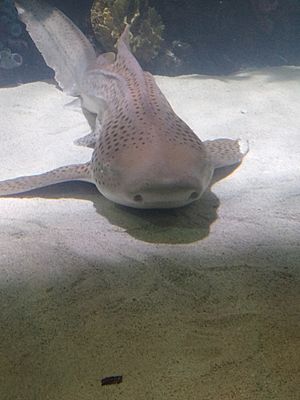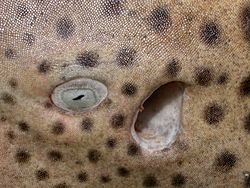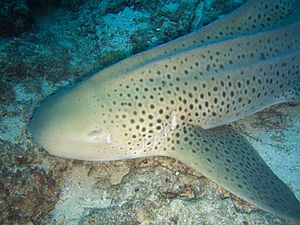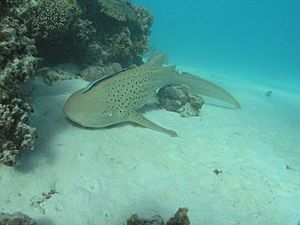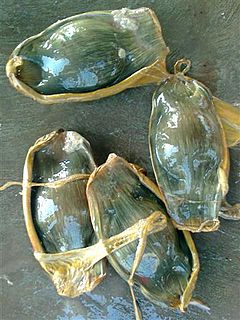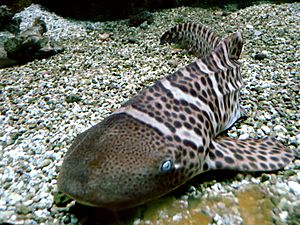Zebra shark facts for kids
Quick facts for kids Zebra shark |
|
|---|---|
 |
|
| Conservation status | |
| Scientific classification | |
| Genus: |
Stegostoma
|
| Species: |
tigrinum
|
 |
|
| Range of the zebra shark | |
| Synonyms | |
|
Scyllia quinquecornuatum van Hasselt, 1823 |
|
The zebra shark (Stegostoma tigrinum) is a type of carpet shark. It is the only member of its family, called Stegostomatidae. These sharks live in the warm waters of the Indo-Pacific ocean. They like to hang out near coral reefs and sandy areas. You can find them down to about 62 meters (203 feet) deep.
Adult zebra sharks look very special. They have five long ridges on their body. Their tail fin is very long, almost half their total length. They usually have dark spots on a light background. But young zebra sharks, under 90 cm (35 in) long, look totally different! They have light stripes on a brown background and no ridges. This shark can grow up to 2.5 meters (8.2 feet) long.
Zebra sharks are active at night. During the day, they mostly rest on the seafloor. At night, they hunt for molluscs, crustaceans, and small bony fishes. They might even eat sea snakes. They search for food in holes and cracks in the reef. Most of the year, they live alone. But sometimes, they gather in large groups.
Female zebra sharks lay eggs. These eggs are in large capsules called mermaid's purses. They stick these capsules to things underwater. Zebra sharks are not dangerous to humans. They are also easy to keep in aquariums. Because of this, they are popular for ecotourism dives and in public aquaria. The World Conservation Union says this shark is Endangered. This is because people catch them for food, fins, and oil. Their numbers are getting smaller in most places.
Contents
About the Zebra Shark's Name
The zebra shark got its first scientific name, Squalus varius, in 1758. Later, in 1837, scientists Müller and Henle put it in the group Stegostoma. For a long time, there was confusion about its exact scientific name.
Recently, in 2019, scientists decided that Stegostoma tigrinum is the correct name. This name was given by Forster in 1781. This makes it the oldest and most valid name for the species.
The name Stegostoma comes from Greek words. Stego means "covered" and stoma means "mouth". The name fasciatum means "banded," which describes the stripes on young sharks. This is also why we call them "zebra sharks."
Sometimes, adult zebra sharks are called "leopard sharks" because of their spots. But "leopard shark" usually refers to a different shark, the Triakis semifasciata. It can also sometimes mean the tiger shark. Young zebra sharks look so different from adults that people once thought they were different species!
How Zebra Sharks Look
The zebra shark has a body shaped like a cylinder. Its head is a bit flat, and its snout is short and blunt. Its eyes are small and on the sides of its head. Behind the eyes are spiracles, which are breathing holes. These spiracles are as big as or bigger than the eyes.
It has five short gill slits for breathing. The last three are above its large pectoral fins. Its nostrils have small whiskers called barbels. There is also a groove from the nostril to the mouth. The mouth is almost straight. It has many rows of teeth, each with a large point and two smaller ones.
Adult zebra sharks have five clear ridges along their body. One ridge runs down the middle of its back. Two more are on each side. The ridge on the back connects to the first dorsal fin. This fin is about halfway down the body and is twice as big as the second dorsal fin. The pectoral fins are wide. The pelvic and anal fins are smaller. The tail fin is very long, almost as long as the rest of the body.
Zebra sharks can grow up to 2.5 meters (8.2 feet) long. There's even a report of one being 3.5 meters (11.5 feet), but this is not confirmed. Males and females are about the same size.
Color Changes as They Grow
Young zebra sharks are dark brown on top and light yellow underneath. They have yellow stripes and spots. As they grow to about 50 to 90 cm (20 to 35 in), their dark areas break up. This changes their pattern from light stripes on dark to dark spots on light.
Each adult shark has a unique spot pattern. This helps people tell them apart. There is also a rare type called the "sandy zebra shark." It is mostly sandy-brown with faint dark freckles. It does not have the clear spots and bands. We don't know what young sandy zebra sharks look like. But subadults have a brown net-like pattern. This sandy type is mostly found near Malindi in Kenya.
In 1964, a partially albino zebra shark was found. It was white and had no spots. But its eyes were dark, not red like full albinos. Albino animals usually don't live long in the wild. This is because their lack of color makes it hard for them to hide.
Where Zebra Sharks Live
Zebra sharks live in the warm waters of the Indo-Pacific region. This area stretches from South Africa to the Red Sea and the Persian Gulf. It includes places like Madagascar, the Maldives, India, and Southeast Asia. You can also find them north to Taiwan and Japan, and south to northern Australia.
These sharks live on the bottom of the ocean. They are found from the shallow areas near the shore down to 62 meters (203 feet) deep. Adults and large young sharks prefer coral reefs, rocky areas, and sandy spots. There are some reports of them in fresh water in the Philippines, but this is not confirmed.
Zebra sharks can swim across open ocean waters to reach isolated underwater mountains. Some sharks have traveled as far as 140 km (87 miles). However, studies show that different groups of zebra sharks don't mix much, even if their homes are close.
Zebra Shark Behavior and Diet
During the day, zebra sharks are slow. They usually rest on the seafloor. Sometimes, they use their pectoral fins to prop up their front body. They face into the current with their mouths open. This helps them breathe better. Reef channels are good resting spots because the water flows faster there, bringing more oxygen.
They become more active at night or when food is around. Zebra sharks are strong and graceful swimmers. They move their bodies and tails like an eel to swim. In a strong current, they can stay in one place by waving their tails.
Zebra sharks mainly eat shelled molluscs. They also eat crustaceans, small bony fishes, and possibly sea snakes. Their slim, flexible bodies let them wiggle into tight holes and cracks to find food. Their small mouth and strong mouth muscles help them suck out prey. Larger fish, especially other sharks, and marine mammals might hunt zebra sharks.
Social Life of Zebra Sharks
Zebra sharks usually live alone. But sometimes, groups of 20 to 50 sharks have been seen together. Off southeast Queensland, hundreds of adult zebra sharks gather every summer in shallow water. In these groups, there are almost three times more females than males.
Scientists are not sure why they gather like this. No clear mating behavior has been seen during these gatherings. There was one time an adult male bit another male's pectoral fin and pushed him to the seafloor. The second male turned on his back and stayed still. This might be a way for one shark to show dominance over another.
Reproduction and Life Cycle
When zebra sharks mate, the male follows the female. He bites her pectoral fins and tail. Sometimes, he holds onto her pectoral fin, and they both lie still on the bottom. Then, the male wraps his body around the female. He inserts one of his claspers into her cloaca (a body opening).
Zebra sharks lay eggs. The female lays large egg capsules. These capsules are about 17 cm (6.7 in) long, 8 cm (3.1 in) wide, and 5 cm (2 in) thick. The egg case is dark brown to purple. It has hair-like fibers on the sides. These fibers help the egg case stick to things underwater.
The female releases these fibers first. She swims around tall things like reef rocks to tangle the fibers. This anchors the eggs. Females have been seen laying up to 46 eggs over 112 days. They usually lay eggs in groups of about four. We don't know much about when they reproduce in the wild.
In aquariums, the eggs hatch after four to six months. This depends on the water temperature. The baby sharks are 20 to 36 cm (7.9 to 14.2 in) long when they hatch. Their tails are longer compared to their bodies than adult sharks. We are not sure where young sharks prefer to live. Some say they live deeper than 50 meters (164 feet). Others say they live in shallower water than adults. The stripes on young sharks might help them hide from predators.
Males become adults when they are 1.5 to 1.8 meters (4.9 to 5.9 feet) long. Females become adults at 1.7 meters (5.6 feet) long. They are thought to live for 25 to 30 years in the wild. There have been two cases of female zebra sharks having babies without a male. This is called asexual reproduction.
Zebra Sharks and People
Zebra sharks are calm and slow. They are not dangerous to humans. Divers can easily get close to them underwater. However, they have bitten divers who pulled their tails or tried to ride them. As of 2008, there is one record of an unprovoked attack. No one was hurt in that incident.
These sharks are popular for ecotourism dives. You can see them in the Red Sea, the Maldives, Thailand, and the Great Barrier Reef. Many zebra sharks at diving spots are used to people. They will take food from divers' hands and let themselves be touched.
Zebra sharks do well in captivity. Many public aquariums around the world have them. Small, colorful young sharks are sometimes bought by private collectors. But this species grows too big for a home aquarium.
People catch zebra sharks in many parts of the world. They use nets and long lines. The meat is sold fresh or dried and salted. Their liver oil is used for vitamins. Their fins are used for shark fin soup. Other parts are used for fishmeal.
Zebra sharks are easily affected by overfishing. This is because they live in shallow waters and don't travel far between groups. Studies show they are much less common now than before. Their homes, the coral reefs, are also being damaged by human activities. Destructive fishing methods, like using dynamite or poison, also hurt them.
Because of these threats, the World Conservation Union says this species is Endangered. However, off Australia, they are only caught a little bit by accident. So, in Australia, they are considered of Least Concern.
See also
 In Spanish: Tiburón zebra para niños
In Spanish: Tiburón zebra para niños



